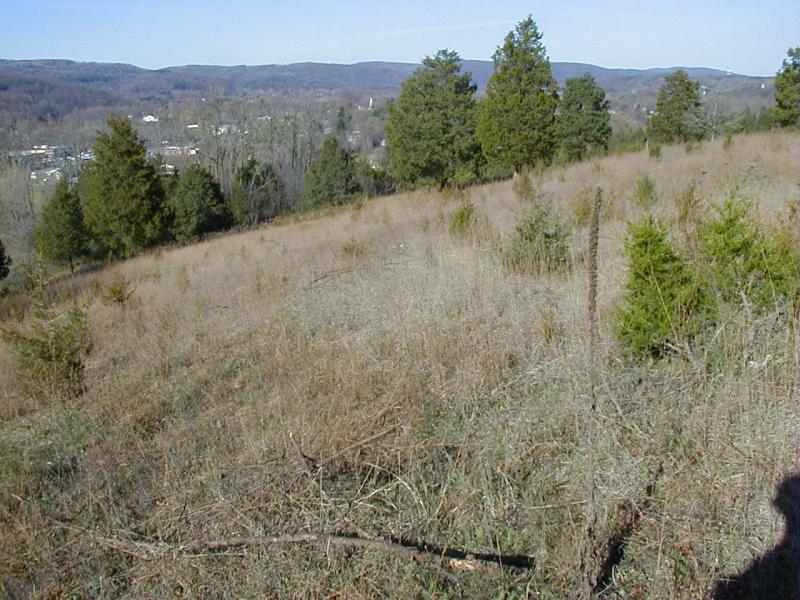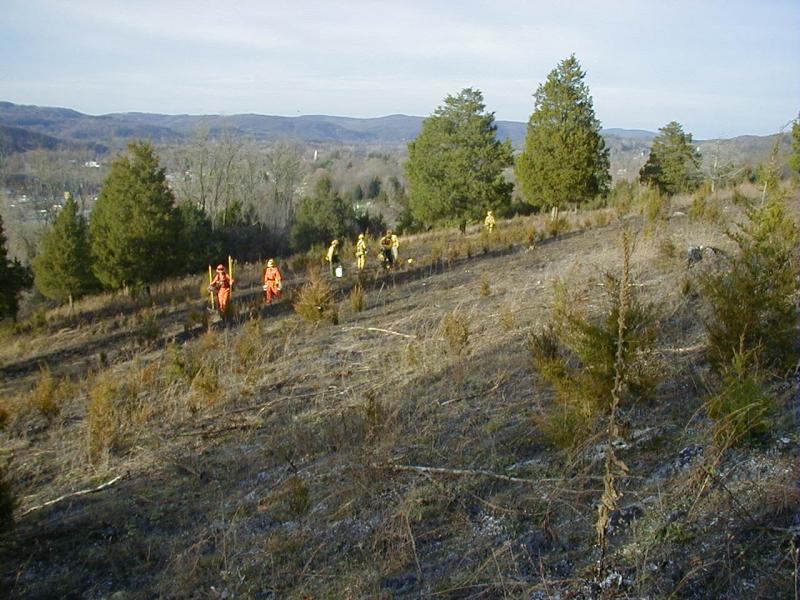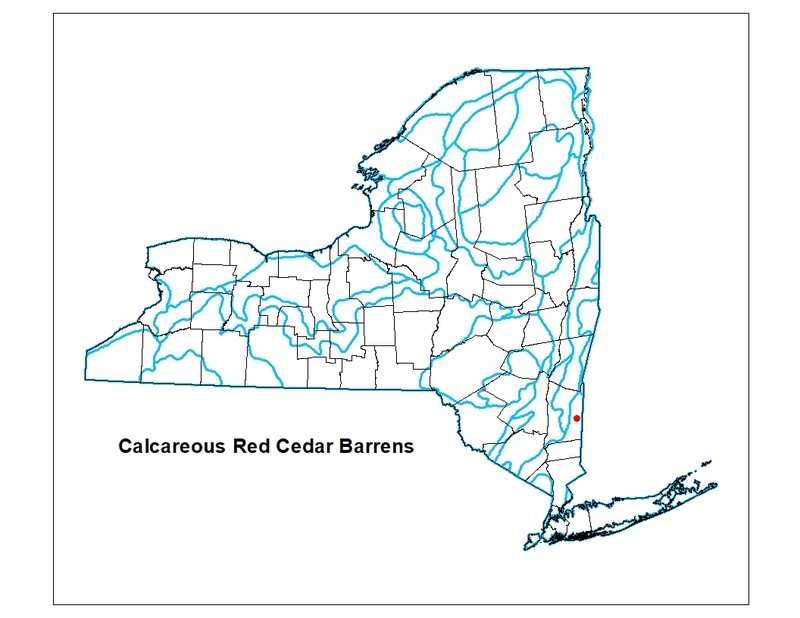Calcareous Red Cedar Barrens
- System
- Terrestrial
- Subsystem
- Barrens And Woodlands
- State Protection
- Not Listed
Not listed or protected by New York State.
- Federal Protection
- Not Listed
- State Conservation Status Rank
- S1
Critically Imperiled in New York - Especially vulnerable to disappearing from New York due to extreme rarity or other factors; typically 5 or fewer populations or locations in New York, very few individuals, very restricted range, very few remaining acres (or miles of stream), and/or very steep declines.
- Global Conservation Status Rank
- G1G2
Critically Imperiled or Imperiled globally - At very high or high risk of extinction due to rarity or other factors; typically 20 or fewer populations or locations in the world, very few individuals, very restricted range, few remaining acres (or miles of stream), and/or steep declines. More information is needed to assign either G1 or G2.
Summary
Did you know?
Eastern red cedar (Juniperus virginiana) is dioecious. This means that some trees are female and some trees are male. The male trees have pollen-producing flowers and the female trees produce the familiar light blue "juniper berries." These "berries" are technically cones with fleshy blue scales and a white waxy cover, giving the them an overall sky-blue color. They are a favorite food of cedar waxwings and other birds, which disperse the seeds to other locations.
State Ranking Justification
There are very few occurrences of this community in New York. One documented occurrence has fair viability and is protected on private conservation land. In New York, calcareous red cedar barrens are apparently strongly correlated with the presence of Stockbridge Marble bedrock and the Farmington-Rock soil unit. There are no large, high quality examples known in the state. The current trend of this community is probably stable for the one occurrence on private conservation land, and very likely declining elsewhere due to moderate threats related to fire suppression, invasive species, and development pressure.
Short-term Trends
The number and acreage of calcareous red cedar barrens in New York have probably remained stable or have declined in recent decades with one example protected within a preserve. The status of other examples is unknown, but likely declining due to conversion to agricultural purposes or other development. In addition, fire suppresion and the subsequent invasion by woody species has resulted in a decline of the size of occurrences.
Long-term Trends
The number and acreage of calcareous red cedar barrens in New York have probably had a large decline from historical numbers, likely correlated with the onset of agricultural and residential development. There were probably very few historical occurrences.
Conservation and Management
Threats
The main threats to calcareous red cedar barrens are fire suppression/woody plant invasion, non-native invasive species, and agricultural or other development. The most invasive plants associated with this community include buckthorn (Rhamnus cathartica), common barberry (Berberis vulgaris), Oriental bitter-sweet (Celastris orbiculatus), and spotted knapweed (Centaurea biebersteinii).
Conservation Strategies and Management Practices
Increase and/or maintain the size of existing calcareous red cedar barrens by increasing patch size where appropriate, by "softening" the abrupt forest edges by maintaining a native shrub transition zone. Improve the condition of existing calcareous red cedar barrens by reducing and/or eliminating invasive species (including invasive native woody species), minimizing trail network and clearly marking existing trails, and developing and implementing a prescribed burn plan at appropriate sites. Improve the landscape context by encouraging surrounding landowners to establish natural buffers and restore natural corridors to other larger natural landscape blocks (Edinger 2003).
Development and Mitigation Considerations
Soils are very thin within and around this community, and the effect of clearing and construction on soil retention and erosion must be considered prior to any development activities. These soils are circumneutral, and any excessive soil enrichment contamination (e.g., from septic leach fields or fertilized lawns) of this community can alter community structure and function. The open structure of this community is maintained by fire and presents a fire hazard to existing and proposed development. Unprotected structures located within or near this community are more susceptible to damage from fire.
Inventory Needs
Given the apparent strong correlation of calcareous red cedar barrens with Stockbridge Marble and the Farmington-Rock soil unit, a systematic search is needed to find where these two layers intersect in eastern New York (Edinger 2003). This search could be augmented with historical specimen data (e.g., Bouteloua curtipendula locations) to narrow the field of search. If these and other layers, such as elevation, aspect, slope, convexity were combined using GIS it may be possible to build a powerful predicative model to find more examples of calcareous red cedar barrens.
Research Needs
Determine the optimal fire regime for this community. The effect of prescribed burning needs to be evaluated.
Rare Species
- Agastache nepetoides (Yellow Giant Hyssop) (guide)
- Anticlea elegans var. glauca (White Death Camas) (guide)
- Asclepias viridiflora (Green Milkweed) (guide)
- Blephilia ciliata (Downy Wood Mint) (guide)
- Bouteloua curtipendula var. curtipendula (Side Oats Grama) (guide)
- Cirriphyllum piliferum (Hair-pointed Moss) (guide)
- Corydalis aurea (Golden Corydalis) (guide)
- Cypripedium arietinum (Ram's Head Lady's Slipper) (guide)
- Draba glabella (Smooth Whitlow Grass) (guide)
- Epilobium hornemannii ssp. hornemannii (Alpine Willowherb) (guide)
- Linum sulcatum (Grooved Yellow Flax) (guide)
- Lithospermum virginianum (Virginia False Gromwell) (guide)
- Myurella julacea (Small Mousetail Moss) (guide)
- Platydictya jungermannioides (False Willow Moss) (guide)
- Pycnanthemum clinopodioides (Basil Mountain Mint) (guide)
- Tomostima reptans (Carolina Whitlow Grass) (guide)
- Ulmus thomasii (Rock Elm) (guide)
Range
New York State Distribution
Currently limited to one occurrence in Dutchess County, but may extend north and south following the extent of Stockbridge Marble bedrock in eastern New York.
Global Distribution
This community has a scattered distribution associated with calcareous bedrock (typically marble) that includes western Connecticut, eastern New York, northern New Jersey, and central Pennsylvania.
Best Places to See
- Nellie Hill Preserve
Identification Comments
General Description
This is a small-patch community with dry, south-facing to southwest-facing slopes of calcareous bedrock that support stunted, sparse woodlands with small grassland openings characterized by little blue stem (Schizachyrium scoparium) and side-oats grama (Bouteloua curtipendula). Red cedar (Juniperus virginiana) is usually present as a stunted, sparse canopy. Shrubs are sparse, but when present may include hackberry (Celtis occidentalis). The herbaceous composition is quite variable and diverse but often includes such species as bristle-leaf sedge (Carex eburnea), thimbleweeds (Anemone virginiana), switch-grass (Panicum virgatum), Indian grass (Sorghastrum nutans), Pennsylvania sedge (Carex pensylvanica), green milkweed (Asclepias viridiflora), whorled milkweed (Asclepias verticillata), and creeping muhly (Muhlenbergia sobolifera).
Characters Most Useful for Identification
This community appears to be associated with Stockbridge Marble bedrock and the Farmington-Rock soil unit in eastern NY. Sparse woodlands with stunted red cedar and marble outcrops with clump-forming grasses are characteristic of this community.
Elevation Range
Known examples of this community have been found at elevations between 400 feet and 540 feet.
Best Time to See
Late summer is a good time to see side-oats grama (Bouteloua curtipendula var. curtipendula) in the grassy openings of the calcareous red cedar barrens.
Calcareous Red Cedar Barrens Images
Classification
NatureServe Ecological Systems
This New York natural community falls into the following ecological system(s). Ecological systems are often described at a coarser resolution than New York's natural communities and tend to represent clusters of associations found in similar environments. The ecological systems project is developed and maintained by NatureServe.
- Central Appalachian Alkaline Glade and Woodland (CES202.602)
Characteristic Species
-
Trees > 5m
- Betula papyrifera (paper birch)
- Fraxinus americana (white ash)
- Juniperus virginiana var. virginiana (eastern red cedar)
- Ostrya virginiana (hop hornbeam, ironwood)
- Quercus muehlenbergii (yellow oak, chinquapin oak)
- Tilia americana var. americana (American basswood)
-
Shrubs 2 - 5m
- Celtis occidentalis (northern hackberry)
- Cornus alternifolia (pagoda dogwood, alternate-leaved dogwood)
- Corylus americana (American hazelnut)
- Corylus cornuta ssp. cornuta (beaked hazelnut)
- Juniperus virginiana var. virginiana (eastern red cedar)
- Quercus prinoides (dwarf chestnut oak)
-
Herbs
- Anemone cylindrica (long-headed anemone)
- Anemone virginiana (tall anemone, thimbleweed)
- Asclepias verticillata (whorled milkweed)
- Asclepias viridiflora (green milkweed)
- Bouteloua curtipendula var. curtipendula (side-oats grama)
- Carex eburnea (bristle-leaved sedge)
- Carex pensylvanica (Pennsylvania sedge)
- Lespedeza spp.
- Muhlenbergia sobolifera (rock muhly)
- Onosmodium spp.
- Packera aurea (golden ragwort)
- Packera obovata (round-leaved ragwort)
- Panicum virgatum (switch grass)
- Pellaea atropurpurea (purple cliff-brake)
- Pycnanthemum incanum var. incanum (hoary mountain-mint)
- Pycnanthemum virginianum (Virginia mountain-mint)
- Schizachyrium scoparium var. scoparium (little bluestem)
- Solidago bicolor (silver-rod)
- Sorghastrum nutans (Indian grass)
- Sporobolus compositus var. compositus (rough dropseed)
- Triosteum aurantiacum (orange-fruited horse-gentian)
Similar Ecological Communities
- Calcareous talus slope woodland
(guide)
Calcareous talus slope woodlands tend to be more forested and less prone to fire than calcareous red cedar barrens. The predominance of talus in the ground layer is another useful indicator of calcareous talus slope woodland.
- Limestone woodland
(guide)
Calcareous red cedar barrens may occur either on summits or the upper convex slopes of small mountains, whereas limestone woodlands typically occur on nearly level limestone bedrock and generally have greater tree canopy cover.
- Red cedar rocky summit
(guide)
Red cedar rocky summits look similar to calcareous red cedar barrens, but red cedar rocky summits can occur on a wide range of bedrock types (typically circumneutral) whereas the barrens appear to be restricted to marble bedrock. The barren also tend to have a greater diversity and abundance of calciphilic plants, such as side-oats grama (Bouteloua curtipendula var. curtipendula), yellow oak (Quercus muhlenbergii), and purple cliff brake (Pellaea atropurpurea).
- Rocky summit grassland
(guide)
Rocky summit grasslands are usually found on acidic to cirmumneutral bedrock. Calcareous red cedar barrens appear to be restricted to marble bedrock and have a greater number and abundance of calciphilic plants.
- Successional red cedar woodland
Successional red cedar woodlands usually form in abandoned agricultural fields and are typically dominated by even-aged red cedar and less diverse than calcareous red cedar barrens.
Vegetation
Percent cover
This figure helps visualize the structure and "look" or "feel" of a typical Calcareous Red Cedar Barrens. Each bar represents the amount of "coverage" for all the species growing at that height. Because layers overlap (shrubs may grow under trees, for example), the shaded regions can add up to more than 100%.
Additional Resources
References
Edinger, G. J., D. J. Evans, S. Gebauer, T. G. Howard, D. M. Hunt, and A. M. Olivero (editors). 2014. Ecological Communities of New York State. Second Edition. A revised and expanded edition of Carol Reschke’s Ecological Communities of New York State. New York Natural Heritage Program, New York State Department of Environmental Conservation, Albany, NY. https://www.nynhp.org/ecological-communities/
Edinger, Gregory J. 2003. Nellie Hill: A calcareous red cedar barrens. Assessment and classification of the red cedar communities at Nellie Hill, Dutchess County, NY. A report prepared for the Eastern New York Chapter of The Nature Conservancy. New York Natural Heritage Program, New York State Department of Environmental Conservation. Albany, NY. 40 pp. plus appendices.
Edinger, Gregory J., D.J. Evans, Shane Gebauer, Timothy G. Howard, David M. Hunt, and Adele M. Olivero (editors). 2002. Ecological Communities of New York State. Second Edition. A revised and expanded edition of Carol Reschke's Ecological Communities of New York State. (Draft for review). New York Natural Heritage Program, New York State Department of Environmental Conservation. Albany, NY. 136 pp.
Grossman, D. H., K. Lemon Goodin, and C. L. Reuss, editors. 1994. Rare plant communities of the conterminous United States: An initial survey. The Nature Conservancy. Arlington, VA. 620 pp.
New York Natural Heritage Program. 2024. New York Natural Heritage Program Databases. Albany, NY.
Reschke, Carol. 1990. Ecological communities of New York State. New York Natural Heritage Program, New York State Department of Environmental Conservation. Latham, NY. 96 pp. plus xi.
Links
About This Guide
Information for this guide was last updated on: January 23, 2024
Please cite this page as:
New York Natural Heritage Program. 2024.
Online Conservation Guide for
Calcareous red cedar barrens.
Available from: https://guides.nynhp.org/calcareous-red-cedar-barrens/.
Accessed July 27, 2024.



